White or beige, but never black, the “desert truffle” is a rare delicacy with a dedicated marketplace in Kuwait, where remnants of the Iraqi invasion and changing weather patterns have decimated local production.
Less prestigious and less expensive than its darker cousin, the Middle Eastern truffle is a prized ingredient for Bedouins, who integrate it into their traditional rice and meat dishes or in sauces, boiled with onions.
On the outskirts of Kuwait City, in al-Rai industrial district, connoisseurs begin perusing the truffle souk at 9am, surveying the various weights and colors and using their noses to select the best fungus by smell.
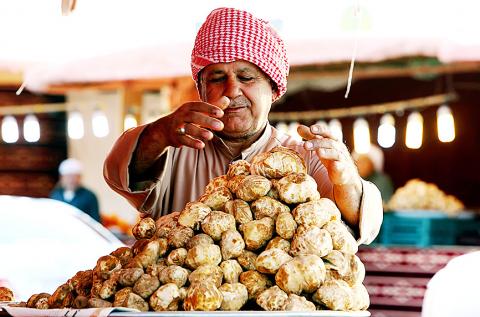
Photo: AFP
Some barter while others go straight for the top shelf, with the “Zebidi” variety especially prized for its use in traditional recipes.
Demand is so high in the Persian Gulf emirate’s market that each year hundreds of merchants compete for limited stall space during the cooler winter months.
The market was devised by the municipality of al-Rai, an industrial zone just northwest of Kuwait City that oversees quality control and guarantees the traceability of the fungus.
“We decided to build this market in 2006 to organize sales of this product, which you used to find in all sorts of corners in Kuwait,” Kuwait City Vice Governor Faisal al-Jomaa said.
This year, 520 merchants applied for one of the 9m2 stalls, he said.
Just 123 vendors secured space.
One of them was Iranian Abdel Ali Said, who has bought and sold truffles since the 1960s.
“They come from Iran, Saudi Arabia, Morocco, Tunisia, Libya and beyond,” he said of his truffle selection.
Prices range from 7 to 20 Kuwaiti dinars (US$23.36 to US$66.74) per kilogram, depending on the quality, he said.
This year, the market is reportedly flooded with truffles from Libya.
“That happens every six years,” Kuwaiti merchant Mohammed al-Shammari said in the truffle market.
“Production is cyclical. You also have a lot coming from Tunisia this year,” he added.
To drive home exactly how popular truffles are among Kuwaitis, al-Shammari said that “three to four tonnes are imported daily, and sold fresh.”
However, for all its love of truffles, Kuwait’s own commercial cultivation and harvesting of the fungus has plummeted to zero since Iraq invaded the Persian Gulf emirate in 1990.
The risk of coming across an unexploded land mine left behind by the Iraqi Army keeps Kuwaitis from scouting the desert for wild truffles. The only remaining production is purely for personal consumption.
Kuwait’s truffle crops have also been hit by a changing environment.
Unlike European truffles, which grow under tree roots, desert truffles spring up after rain, which means that volume and quality vary according to the amount of precipitation and the general weather.
“Irregular rainfall, rapid urbanization and encroachment on the desert are all factors in the disappearance of [local] truffles,” al-Jomaa said.
That has only increased desire for the delicacy, especially for making Kabsa, a spiced rice speciality common throughout the Persian Gulf and the most popular dish in Kuwait.
The main ingredients are long-grain rice, red meat and truffles, used to flavor the broth while cooking.
“Kuwaitis are addicted to truffles, because they are rare and have such a distinct taste,” said Yousef Mohammed al-Khaled, a young truffle aficionado, who claims he can distinguish between various subvarieties.
Khaled said he spends up to 3,000 dinars each year on white truffles, which he incorporates into his diet twice a week, including family lunches on Thursdays, the last day of the work week.
Fresh truffles are only available from November to April in Kuwait, but some vendors sell a dried variation of the delicacy during the region’s scorching summer months in a bid to meet their customers’ cravings all year round.
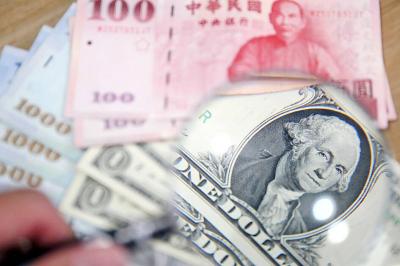
The US dollar was trading at NT$29.7 at 10am today on the Taipei Foreign Exchange, as the New Taiwan dollar gained NT$1.364 from the previous close last week. The NT dollar continued to rise today, after surging 3.07 percent on Friday. After opening at NT$30.91, the NT dollar gained more than NT$1 in just 15 minutes, briefly passing the NT$30 mark. Before the US Department of the Treasury's semi-annual currency report came out, expectations that the NT dollar would keep rising were already building. The NT dollar on Friday closed at NT$31.064, up by NT$0.953 — a 3.07 percent single-day gain. Today,
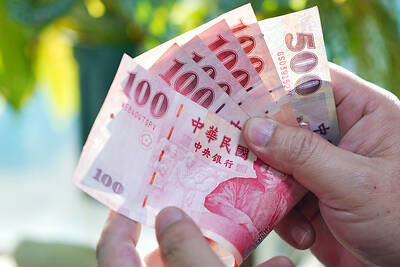
‘SHORT TERM’: The local currency would likely remain strong in the near term, driven by anticipated US trade pressure, capital inflows and expectations of a US Fed rate cut The US dollar is expected to fall below NT$30 in the near term, as traders anticipate increased pressure from Washington for Taiwan to allow the New Taiwan dollar to appreciate, Cathay United Bank (國泰世華銀行) chief economist Lin Chi-chao (林啟超) said. Following a sharp drop in the greenback against the NT dollar on Friday, Lin told the Central News Agency that the local currency is likely to remain strong in the short term, driven in part by market psychology surrounding anticipated US policy pressure. On Friday, the US dollar fell NT$0.953, or 3.07 percent, closing at NT$31.064 — its lowest level since Jan.
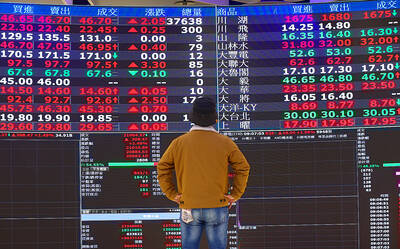
The New Taiwan dollar and Taiwanese stocks surged on signs that trade tensions between the world’s top two economies might start easing and as US tech earnings boosted the outlook of the nation’s semiconductor exports. The NT dollar strengthened as much as 3.8 percent versus the US dollar to 30.815, the biggest intraday gain since January 2011, closing at NT$31.064. The benchmark TAIEX jumped 2.73 percent to outperform the region’s equity gauges. Outlook for global trade improved after China said it is assessing possible trade talks with the US, providing a boost for the nation’s currency and shares. As the NT dollar
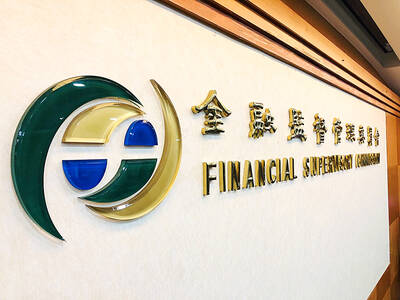
The Financial Supervisory Commission (FSC) yesterday met with some of the nation’s largest insurance companies as a skyrocketing New Taiwan dollar piles pressure on their hundreds of billions of dollars in US bond investments. The commission has asked some life insurance firms, among the biggest Asian holders of US debt, to discuss how the rapidly strengthening NT dollar has impacted their operations, people familiar with the matter said. The meeting took place as the NT dollar jumped as much as 5 percent yesterday, its biggest intraday gain in more than three decades. The local currency surged as exporters rushed to